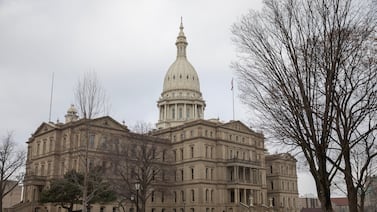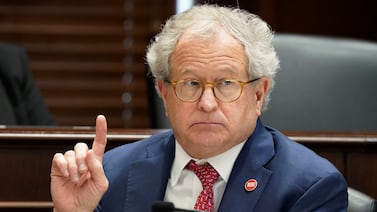This story about teacher-residency programs was produced by The Hechinger Report, a nonprofit, independent news organization focused on inequality and innovation in education. It is republished here with permission. Sign up for the Hechinger newsletter here.
Jaci Grado has wanted to be an educator since she was in kindergarten.
Her love of teaching solidified in high school when she worked at an after-school program in her hometown of Schuyler, Nebraska. The biggest employer in Schuyler is the Cargill beef processing plant, which relies on immigrant labor. More than 70% of the town’s 6,500 residents are Hispanic, including Grado, whose parents immigrated from Mexico.
The second-biggest employer is the school system, which struggles to find and keep qualified teachers, much like rural communities nationwide.
Grado is now wrapping up her sophomore year in the University of Nebraska-Lincoln’s teacher-training program. The first person in her family to go to college, she has been able to attend thanks to a scholarship program co-directed by UNL and Kansas State University to support aspiring teachers from rural places like Schuyler who could fill vacancies in their hometown schools.
“I never would have thought it was possible for me to come to a university like this one,” said Grado. “This was kind of like a dream that came true.”
Now that dream is in jeopardy because the scholarship program supporting Grado — like dozens of other efforts to train and retain rural educators — relies on federal grants eliminated by the Trump administration. In February, the Department of Education abruptly canceled $600 million in grants it said promoted “divisive ideologies” such as diversity, equity and inclusion.
Two lawsuits filed in federal court against the cuts — one by the attorneys general of eight Democrat-led states and another by membership organizations of teacher colleges and teacher-residency programs — argued the department did not have the authority to abruptly withhold funds appropriated by Congress and that the cuts would cause “immediate and irreparable harm” to schools and students.
In both cases, district courts temporarily restored funding, but in April, those judgments were overruled — one by the U.S. Supreme Court and the other by the U.S. Court of Appeals for the 4th Circuit — allowing the cancellations to stay in place until further judicial review.
The Education Department, which did not respond to interview requests, has never provided a complete list of the terminated grants. But they included money for more than 200 projects under three programs designed to recruit and train teachers through scholarships, teacher-residency programs, mentoring, professional development and salary bonuses tied to gains in student learning. The funding cuts have forced many of those initiatives to lay off staff, withdraw scholarships, and shut down altogether.
In some cases, delays in official termination notices combined with emergency funding from universities and foundations have kept programs operating for now, but their long-term prospects are precarious at best, given the Trump administration’s efforts to not only cancel the grant programs but the entire Education Department. Grado’s program has backfilled some money to cover expenses, but not the scholarship portion, which only has guaranteed funding for the remainder of the semester.
Some educators, experts, and advocates say the grant cancellations threaten to exacerbate teacher shortages in many rural communities, forcing schools to rely more on underqualified teachers and worsening outcomes for students. Research on earlier teacher-training projects supported by the same federal grant programs suggest they have helped districts stem teacher vacancies and keep educators in classrooms.
“These types of teacher support programs are critical to rural schools trying to compete for the best teachers for their students,” said Robert Stafford, executive director of the Kentucky Rural Education Association, a nonprofit that supports rural educators. “When you’ve made those plans and developed partnerships and understandings with universities and others, and then you have that support pulled out from underneath you, it can be devastating for a small school district.”
Rural school districts hit hard by teacher shortages
Research consistently shows that high-quality teachers are the most important factor in student achievement — yet there’s a chronic shortage of them in low-income schools. The three grant programs targeted in February — the Teacher Quality Partnership, the Supporting Effective Educator Development, and the Teacher and School Leader Incentive programs — were all established during the Obama administration to bolster the teaching ranks in these high-need districts.
The most severe teacher shortages are in rural areas, largely because of high turnover, according to a 2023 study co-authored by Richard Ingersoll, professor of education and sociology at the University of Pennsylvania. High-poverty rural schools needed to replace 28%of their teachers every year, compared with 19% in high-poverty urban schools, the study found. Teachers were also twice as likely to move from rural to urban or suburban schools as they were to move in the opposite direction.
“It’s not a happy story,” Ingersoll said.
Recent efforts to alleviate teacher shortages have focused on recruiting more local teacher talent. For example, the program supporting Grado, which began in 2023 and was funded by a three-year, $3.4 million federal grant, partners with six rural districts in the region. Dubbed Project RAÍCES (which means roots in Spanish), the program sponsors high school clubs that engage students in local community issues and has awarded 16 full college scholarships to students who plan to pursue teaching with the expectation that they’ll return to lead classrooms in their communities.
Related: To fight teacher shortages, schools turn to custodians, bus drivers and aides
Importantly, Project RAÍCES continues to support new teachers in their first years in the classroom, when quit rates tend to be high, by offering free professional development and paying stipends to experienced educators who serve as mentors, among other ways.
Bret Schroder, superintendent of Schuyler Community Schools, said in recent years his district and others have turned to recruiting teachers from overseas; last year, he hired roughly a dozen teachers from the Philippines. “Nothing against these teachers,” he said. “But would I rather have a plethora of available teachers who grew up here, know the kids and their families and are already embedded in the community? Absolutely.”
Many of the imperiled programs support teacher residencies, modeled on medical residencies, that combine coursework with teaching jobs and pair scholarships with a commitment to teach in a district partnering with the program. While many of the specific programs were too new to demonstrate results, studies of other teacher residencies and of programs providing ongoing support for budding educators show the models can help. For example, one report on teacher-residency programs nationwide cited research suggesting that 50% of teachers in high-needs schools leave the profession within five years, while 70 to 80% of participants in residency programs are not only still in the profession, but in the same district, after five years.
At East Carolina University, a residency program called edPirate supports 10 new teachers a year who commit to spending three years in one of six rural districts. The initiative (named after the East Carolina mascot) began in 2022 with a five-year, $4.8 million federal grant. When their funding was terminated in February, the program’s leaders scrambled to find emergency support from university sources to cover their stipends for the remainder of the semester, but they had to let go of project staff, cancel contracts for things like program evaluation and certification support, and stop all recruiting efforts for next year’s crop of teachers.
One of the rural districts partnering with ECU is Elizabeth City-Pasquotank, in North Carolina, where about 450 teachers serve a coastal town of about 19,000 people. Elizabeth City Superintendent Keith Parker said federal funding has been essential to districts like his with smaller populations and lower tax revenues. He credited the support for helping him attract applicants and reduce vacancies from more than 40 in the summer of 2022 to only four today. (Parker noted that vacancies peak in the summer and said he anticipated them to tick up before the next academic year.)
“These grants have allowed us to be competitive,” he said. “We’ve been able to say to a young college graduate, ‘Come here and teach, commit to us, because there are opportunities for you to grow here.’”
In addition, Parker said the terminated grants paid the salaries of at least four teachers, and the district needed to find a couple hundred thousand dollars immediately to pay them for the remainder of this academic year, requiring the cancellation or postponement of several dozen school maintenance projects, such as repairing leaky roofs.
Parker’s district also partnered with another teacher-pipeline project funded by a recently terminated grant — an initiative to give rural teachers bonuses based on improved student achievement. That project was led by The Innovation Project or TIP, a collaboration of public school systems across North Carolina. Teachers in Elizabeth City and seven other rural districts were expecting to receive performance-based bonuses of up to $7,500 at the end of this school year, but there’s no money now to pay them — a “devastating” loss, according to Parker.
TIP had to lay off support staff and four experienced teacher coaches they had hired from across the state to help mentor new teachers in rural partner districts.
“It was absolutely heartbreaking, to tell people, ‘As of 5 p.m. today, you no longer have a job, and we can’t pay you any sort of severance or anything,’” said Sharon Contreras, TIP’s chief executive officer. “That’s no way to treat this nation’s educators.”
Students skeptical that ‘the money will be there’
The cuts caught educators by surprise. In mid-February, a wave of form letters from the Department of Education, identical except for the recipients’ names and grant numbers, hit the grantees’ inboxes.
The letters, signed by Mark Washington, the department’s deputy assistant secretary for management and planning, informed recipients that their grants were being terminated because they funded “programs that promote or take part in DEI initiatives or other initiatives that unlawfully discriminate on the basis of race, color, religion, sex, national origin, or another protected characteristic.” The letters demanded an immediate stop to all spending and gave recipients 30 days to appeal.
“There was a lot of confusion, and a lot of chaos about what does this actually mean,” said Ben Seipel, a professor of education and graduate program director at California State University-Chico who leads the GREAT Teachers Pipeline, which received a three-year, $13.4 million grant in 2022 to recruit, train and support hundreds of teachers from a largely rural area of Northern California about the size of Ohio. They were in the final year of their grant when it was terminated.
While the university was able to secure enough alternative funding to cover the program’s spring semester obligations, recruiting for next fall’s teachers went forward without assurances that money would be available to support them. Seipel and his team also scaled back plans for summer professional development workshops for teachers in their partner districts, and they shelved plans to track the longer-term impact of the teachers they trained for rural schools after the Education Department canceled the call for new grant applications.
Related: Waiting for the traveling teacher: Remote rural schools need more hands-on help
The primary goal of the three federal grant programs at the center of the legal battles is to train and support skilled teachers for districts that need them most, according to the funding priorities published by the Education Department. But all three also focus on increasing teacher diversity as a secondary goal.
The grantees interviewed for this story said their projects did not rely on quotas or preferences based on race or other demographic categories, as the termination letter alleged. Instead, they said their efforts increased educator diversity by lowering the barriers to pursuing a teaching career and by recruiting local teacher talent from communities with diverse populations. The legal cases center not on questions of diversity, though, but on whether the Education Department has the authority to terminate the grant programs established by Congress.
The decisions of the Supreme Court and the Court of Appeals to let the cancellations stand for now is not promising for the plaintiffs. Regardless of what the courts ultimately decide, it appears likely that the Education Department will end most of its support for teacher-training programs going forward.
President Donald Trump’s executive order to dismantle the department, signed March 20, calls for returning power over education to the states. Already the education agency has lost thousands of staff members through layoffs and resignations, and it is investigating moving some responsibilities, including special education programs, to other agencies such as the Department of Health and Human Services.
“We currently have our applications open for the fall,” said Seipel of Chico State, “but we know that some students are hesitant, because they just can’t trust that the money will be there.”
As for Grado, she’s determined to find a way to finish college, even though she’s not sure how she might pay for it — maybe loans, maybe taking a job at one of the packing plants to save money for tuition. In addition to her classwork, her training includes teaching periodic lessons at a nearby elementary school.
“I love being there, and I constantly think of my kids back home, and how much I would love to return and teach,” she said. “I mean, that’s what I came here for.”
Contact editor Caroline Preston at 212-870-8965 or on Signal at CarolineP.83 or at preston@hechingerreport.org.
This story about teacher-residency programs was produced by The Hechinger Report, a nonprofit, independent news organization focused on inequality and innovation in education. Sign up for the Hechinger newsletter.





